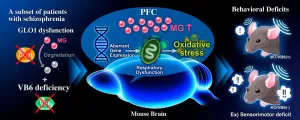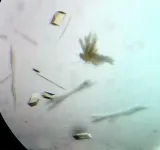Methylglyoxal detoxification deficits causes schizophrenia-like behavioral abnormalities
2021-07-02
(Press-News.org) Methylglyoxal (MG) is a highly reactive α-ketoaldehyde formed endogenously as a byproduct of the glycolytic pathway. MG accumulates under conditions of hyperglycemia, impaired glucose metabolism, or oxidative stress. An excess of MG formation causes mitochondrial impairment and reactive oxygen species (ROS) production that further increases oxidative stress. It also leads to the formation of advanced glycation end products (AGEs) due to MG reacting with proteins, DNA, and other biomolecules, which can induce aberrant inflammation via binding to receptors for AGEs (RAGE). To remove the toxic MG, various detoxification systems work together in vivo, including the glyoxalase system which enzymatically degrades MG using glyoxalase 1 (GLO1) and GLO2, and the MG scavenging system by vitamin B6 (VB6).
Schizophrenia is a heterogeneous psychiatric disorder characterized by positive symptoms, such as hallucinations and delusions, negative symptoms, such as anhedonia and flat affect, and cognitive impairment. We have reported that several patients with schizophrenia have a novel heterozygous frameshift and a single nucleotide variation (SNV) in GLO1 that results in reductions of enzymatic activity. Furthermore, we have reported that VB6 (pyridoxal) levels in peripheral blood of patients with schizophrenia are significantly lower than that of healthy controls. More than 35% of patients with schizophrenia have low levels of VB6 (clinically defined as male: < 6 ng/ml, female: < 4 ng/ml). However, the effects of MG detoxification deficits on the pathophysiology of schizophrenia in vivo remain unclear.
In this study, we created a novel mouse model for MG detoxification deficits by feeding Glo1 knockout mice VB6-deficent diets (KO/VB6(-)) and evaluated the effects of impaired MG detoxification systems on brain function. KO/VB6(-) mice accumulated MG in the PFC, hippocampus, and striatum, and displayed behavioral deficits, such as impairments of social interaction and cognitive memory and a sensorimotor deficit in the PPI test. Furthermore, we found aberrant gene expression related to mitochondria function in the PFC of the KO/VB6(-) mice by RNA-sequencing and weighted gene co-expression network analysis (WGCNA). Finally, we demonstrated abnormal mitochondrial respiratory function and subsequently enhanced oxidative stress in the PFC of KO/VB6(-) mice in the PFC. These findings suggest that MG detoxification deficits may cause the observed behavioral deficits via mitochondrial dysfunction and oxidative stress in the PFC.
This is the first report to show that MG detoxification deficits are involved in the development of schizophrenia. Considering the molecular mechanism revealed in this study, antioxidants to prevent oxidative stress and VB6 supplementation may be effective as a new therapeutic strategy for patients with MG detoxification deficits, GLO1 dysfunction and VB6 deficiency.
INFORMATION:
[Attachments] See images for this press release:

ELSE PRESS RELEASES FROM THIS DATE:
2021-07-02
This insight is the result of the close collaboration of several research groups at the Max Planck Institute for Marine Microbiology. A team around Cedric Hahn and Gunter Wegener recently discovered ethane-degrading microbes at hydrothermal vents of the Guaymas Basin at a water depth of 2,000 meters in the Gulf of California. They named it Ethanoperedens thermophilum, which means "heat-loving ethane-eater". Cedric Hahn a PhD student from the research group Molecular Ecology cultured the ethane-degrading microbes in the laboratory. Hahn, Wegener and colleagues of the research group Microbial Metabolism, Tristan Wagner and Olivier Lemaire took a closer look at these microorganisms. This collaborative work unraveled the secrets behind ...
2021-07-02
"We have studied which temperatures are preferable and which are harmful in humans, cattle, pigs, poultry, and agricultural crops and found that they are surprisingly similar," says Senthold Asseng, Professor of Digital Agriculture at TUM. According to the study, preferable temperatures range from 17 to 24 degrees Celsius.
When does it become too hot for humans?
At high humidity, mild heat strain for humans begins at about 23 degrees Celsius and at low humidity at 27 degrees Celsius. "If people are exposed to temperatures above 32 degrees Celsius at extremely high humidity or above 45 degrees Celsius at extremely low humidity for a lengthy period of time, it can be fatal," says Prof. Asseng. "During extreme heat events with temperatures far above 40 degrees Celsius, such as those ...
2021-07-02
Plastics are a growing problem for natural ecosystems around the globe, and in particular for our marine and freshwater environments. Rivers are the leading source of plastic pollution, as it has been estimated that they deliver several million metric tons of plastic annually to our oceans from poor land-based waste management. The problem is that the estimates made for plastics flowing from the rivers are tens to hundreds of times higher than the quantity of plastics floating on the ocean's surface. So where is all of this river-derived plastic actually going - is there a missing plastic 'sink' somewhere in the ocean? Are the estimates correct?
In a paper published ...
2021-07-02
Originally discovered as a bacterial mode of defense against invading viruses, the remarkable ability of CRISPR-Cas9 to modify specific locations of DNA has made it a researcher favorite among gene editing tools. The ongoing effort to explore further possibilities of the CRISPR-Cas9 system is ushering in newer developments to this tool. In one of the latest refinements of the technique, as illustrated in a study published in BioDesign Research, scientists from Stanford University, USA have developed a CRISPR-Cas9 system that induces highly effective silencing of target genes.
The versatility of CRISPR-Cas9 based gene editing is largely ...
2021-07-02
New research published in The Journal of Physiology shows that researchers have successfully repurposed two existing medications to reduce the severity of sleep apnoea in people by at least 30 per cent.
Affecting around 1.5 million adults in the UK, sleep apnoea is a condition where the upper airway from the back of the nose to the throat closes repetitively during sleep, restricting oxygen intake and causing people to wake as often as 100 times or more per hour (1).
Those with untreated sleep apnoea are more likely to develop cardiovascular disease, dementia and depression, ...
2021-07-02
NDIANAPOLIS--Indiana University School of Medicine researchers are developing a new, noninvasive brain stimulation technique to treat neurological disorders, including pain, traumatic brain injury (TBI), epilepsy, Parkinson's disease, Alzheimer's disease and more.
"Given the increasing use of brain stimulation in human brain study and treatment of neurological diseases, this research can make a big impact on physicians and their patients," said Xiaoming Jin, PhD, associate professor of anatomy, cell biology and physiology.
When someone experiences a brain injury, nerve injury, or neurodegeneration, such as in epilepsy and TBI, there is damage to the brain which can lead to loss ...
2021-07-02
Small children learn language at a pace far faster than teenagers or adults. One explanation for this learning advantage comes not from differences between children and adults, but from the differences in the way that people talk to children and adults.
For the first time, a team of researchers developed a method to experimentally evaluate how parents use what they know about their children's language when they talk to them. They found that parents have extremely precise models of their children's language knowledge, and use these models to tune the language they use when speaking to them. The results are available in an advance online publication ...
2021-07-02
Lugano, Switzerland, 2 July 2021 - Obese patients with colorectal cancer receive lower cumulative doses of adjuvant chemotherapy, relative to their body surface area (BSA), than non-obese patients, show results from a large meta-analysis reported at the ESMO World Congress on Gastrointestinal Cancer 2021 (1). Further findings showed that cumulative relative chemotherapy dose was associated with survival so may explain the poorer survival that has been seen in obese patients receiving adjuvant chemotherapy for colorectal cancer. (2)
"Adjuvant chemotherapy ...
2021-07-02
Lugano, Switzerland, 2 July 2021 - Doctors and patients are being advised to reduce unnecessary antibiotic use following new data suggesting that these medicines may increase the risk of cancer of the large intestine (colon), especially in people under 50 years. (1) The results, presented at the ESMO World Congress on Gastrointestinal Cancer (30 June-3 July) raise fresh concerns about the impact of the estimated 65% increase in global antibiotic consumption reported between 2000 and 2015, despite not showing a direct cause and effect. (2)
"To our knowledge, ...
2021-07-02
Plastic is notoriously hard to break down, but researchers in Austria have found that bacteria from a cow's rumen - one of the four compartments of its stomach - can digest certain types of the ubiquitous material, representing a sustainable way to reduce plastic litter.
The scientists suspected such bacteria might be useful since cow diets already contain natural plant polyesters. "A huge microbial community lives in the rumen reticulum and is responsible for the digestion of food in the animals," said Dr Doris Ribitsch, of the University of Natural Resources and Life Sciences in Vienna, "so we suspected that some biological activities could also be used for polyester hydrolysis," a type of chemical reaction ...
LAST 30 PRESS RELEASES:
[Press-News.org] Methylglyoxal detoxification deficits causes schizophrenia-like behavioral abnormalities



